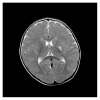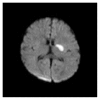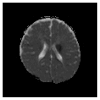Ischemic Stroke in Confederation with Trivial Head Trauma
- PMID: 27313936
- PMCID: PMC4903141
- DOI: 10.1155/2016/2572958
Ischemic Stroke in Confederation with Trivial Head Trauma
Abstract
Minor head injuries in children are common, resulting in brain concussion, and these injuries mostly end up without complications. Usually head trauma results in hemorrhagic stroke. Here we present a case of ischemic stroke following a trivial head trauma. A 10-month-old girl presented with posttraumatic right sided hemiparesis with right sided facial palsy. MRI brain revealed an area of acute infarct in the left capsuloganglionic region. The child was initially managed conservatively, as the hematological parameters were normal, and was started on anticoagulant therapy. An improvement in the clinical condition was achieved in 12 hrs of treatment with gain in power and resolution of weakness in 10 days. The specific cause for hemiparesis in the child is not elicited; possibility of genetic and environmental factors can be attributable.
Figures



References
-
- Kalra V. Practical Paediatric Neurology. 1st. New Delhi, India: Arya Publication; 1999.
LinkOut - more resources
Full Text Sources
Other Literature Sources

